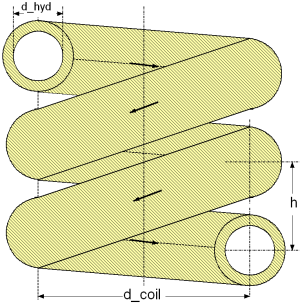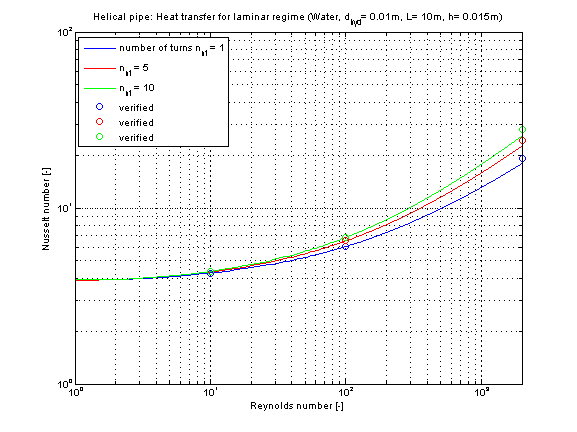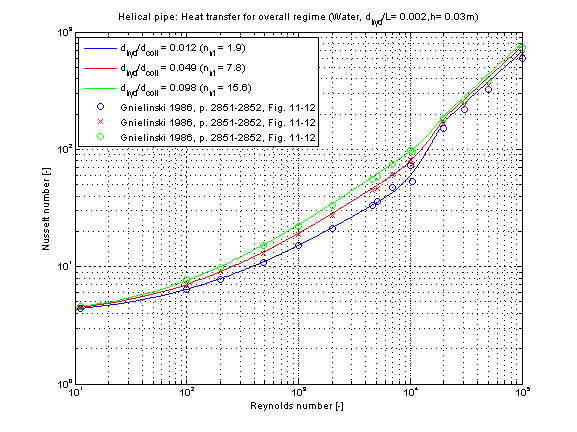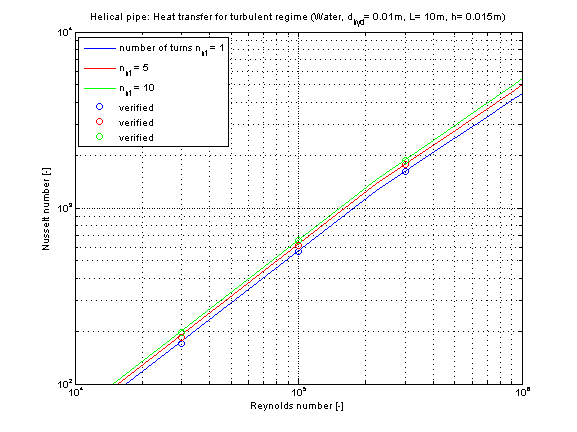 Package Modelica.Fluid.Dissipation.Utilities.SharedDocumentation.HeatTransfer.HelicalPipe
Package Modelica.Fluid.Dissipation.Utilities.SharedDocumentation.HeatTransfer.HelicalPipeIcon for general information packages
 Package Modelica.Fluid.Dissipation.Utilities.SharedDocumentation.HeatTransfer.HelicalPipe
Package Modelica.Fluid.Dissipation.Utilities.SharedDocumentation.HeatTransfer.HelicalPipe
This icon indicates classes containing only documentation, intended for general description of, e.g., concepts and features of a package.
Extends from Modelica.Icons.Information (Icon for general information packages).
| Name | Description |
|---|---|
kc_laminar | |
kc_overall | |
kc_turbulent |
 Class Modelica.Fluid.Dissipation.Utilities.SharedDocumentation.HeatTransfer.HelicalPipe.kc_laminar
Class Modelica.Fluid.Dissipation.Utilities.SharedDocumentation.HeatTransfer.HelicalPipe.kc_laminar
Calculation of the mean convective heat transfer coefficient kc for a helical pipe in the laminar flow regime.
There are basically three differences:
The critical Reynolds number Re_crit in a helical pipe depends on its mean curvature diameter d_coil . The smaller the mean curvature diameter of the helical pipe, the earlier the turbulent regime will start due to vortexes out of higher centrifugal forces.

The mean convective heat transfer coefficient kc for helical pipes is calculated through the corresponding Nusselt number Nu according to [VDI 2002, p. Gc 2, eq. 5] :
Nu = 3.66 + 0.08*[1 + 0.8*(d_hyd/d_coil)^0.9]*Re^m*Pr^(1/3)
with the exponent m for the Reynolds number
m = 0.5 + 0.2903*(d_hyd/d_coil)^0.194
and the resulting mean convective heat transfer coefficient kc
kc = Nu * lambda / d_hyd
with
| d_mean | as mean diameter of helical pipe [m], |
| d_coil = f(geometry) | as mean curvature diameter of helical pipe [m], |
| d_hyd | as hydraulic diameter of the helical pipe [m], |
| h | as slope of helical pipe [m], |
| kc | as mean convective heat transfer coefficient [W/(m2K)], |
| lambda | as heat conductivity of fluid [W/(mK)], |
| L | as total length of helical pipe [m], |
| Nu = kc*d_hyd/lambda | as mean Nusselt number [-], |
| Pr = eta*cp/lambda | as Prandtl number [-], |
| Re = rho*v*d_hyd/eta | as Reynolds number [-], |
| Re_crit = f(geometry) | as critical Reynolds number [-]. |
The mean Nusselt number Nu representing the mean convective heat transfer coefficient kc is shown below for different numbers of turns n_nt at constant total length of the helical pipe.

The convective heat transfer of a helical pipe is enhanced compared to a straight pipe due to occurring turbulences resulting out of centrifugal forces. The higher the number of turns, the better is the convective heat transfer for the same length of a pipe.
Note that the ratio of hydraulic diameter to total length of helical pipe d_hyd/L has no remarkable influence on the coefficient of heat transfer kc .
Extends from Modelica.Icons.Information (Icon for general information packages).
 Class Modelica.Fluid.Dissipation.Utilities.SharedDocumentation.HeatTransfer.HelicalPipe.kc_overall
Class Modelica.Fluid.Dissipation.Utilities.SharedDocumentation.HeatTransfer.HelicalPipe.kc_overall
Calculation of the mean convective heat transfer coefficient kc of a helical pipe in a hydrodynamically developed laminar and turbulent flow regime.
There are basically three differences:
This heat transfer function enables a calculation of heat transfer coefficient for laminar and turbulent flow regime. The geometry, constant and fluid parameters of the function are the same as for kc_laminar and kc_turbulent.
The calculation conditions for laminar and turbulent flow is equal to the calculation in kc_laminar and kc_turbulent. A smooth transition between both functions is carried out between 2200 ≤ Re ≤ 30000 (see figure below).
The mean Nusselt number Nu representing the mean convective heat transfer coefficient kc is shown below for different numbers of turns n_nt at constant total length of the helical pipe.

The convective heat transfer of a helical pipe is enhanced compared to a straight pipe due to occurring turbulences resulting out of centrifugal forces. The higher the number of turns, the better is the convective heat transfer for the same length of a pipe.
Note that the ratio of hydraulic diameter to total length of helical pipe d_hyd/L has no remarkable influence on the coefficient of heat transfer kc .
Extends from Modelica.Icons.Information (Icon for general information packages).
 Class Modelica.Fluid.Dissipation.Utilities.SharedDocumentation.HeatTransfer.HelicalPipe.kc_turbulent
Class Modelica.Fluid.Dissipation.Utilities.SharedDocumentation.HeatTransfer.HelicalPipe.kc_turbulent
Calculation of the mean convective heat transfer coefficient kc of a helical pipe for turbulent flow regime.
There are basically three differences:
The critical Reynolds number Re_crit in a helical pipe depends on its mean curvature diameter. The smaller the mean curvature diameter of the helical pipe d_mean , the earlier the turbulent regime will start due to vortexes out of higher centrifugal forces.

The mean convective heat transfer coefficient kc for helical pipes is calculated through the corresponding Nusselt number Nu according to [VDI 2002, p. Ga 2, eq. 6]:
Nu = (zeta_TOT/8)*Re*Pr/{1 + 12.7*(zeta_TOT/8)^0.5*[Pr^(2/3)-1]},
where the influence of the pressure loss on the heat transfer calculation is considered through
zeta_TOT = 0.3164*Re^(-0.25) + 0.03*(d_hyd/d_coil)^(0.5) and
and the resulting mean convective heat transfer coefficient kc
kc = Nu * lambda / d_hyd
with
| d_mean | as mean diameter of helical pipe [m], |
| d_coil = f(geometry) | as mean curvature diameter of helical pipe [m], |
| d_hyd | as hydraulic diameter of the helical pipe [m], |
| h | as slope of helical pipe [m], |
| kc | as mean convective heat transfer coefficient [W/(m2K)], |
| lambda | as heat conductivity of fluid [W/(mK)], |
| L | as total length of helical pipe [m], |
| Nu = kc*d_hyd/lambda | as mean Nusselt number [-], |
| Pr = eta*cp/lambda | as Prandtl number [-], |
| Re = rho*v*d_hyd/eta | as Reynolds number [-], |
| Re_crit = f(geometry) | as critical Reynolds number [-]. |
The mean Nusselt number Nu representing the mean convective heat transfer coefficient kc is shown below for different numbers of turns n_nt at constant total length of the helical pipe.

The convective heat transfer of a helical pipe is enhanced compared to a straight pipe due to occurring turbulences resulting out of centrifugal forces. The higher the number of turns, the better is the convective heat transfer for the same length of a pipe.
Note that the ratio of hydraulic diameter to total length of helical pipe d_hyd/L has no remarkable influence on the coefficient of heat transfer kc .
Extends from Modelica.Icons.Information (Icon for general information packages).